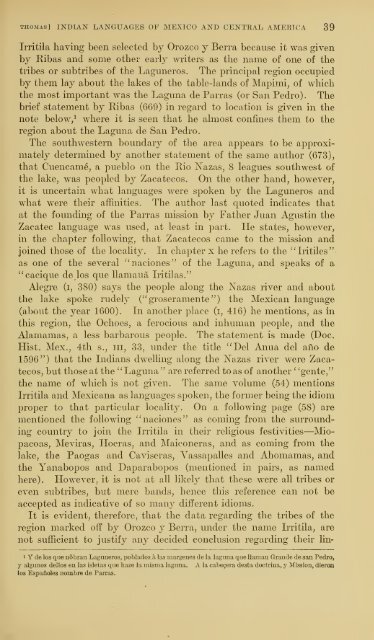Untitled - Smithsonian Institution
Untitled - Smithsonian Institution
Untitled - Smithsonian Institution
You also want an ePaper? Increase the reach of your titles
YUMPU automatically turns print PDFs into web optimized ePapers that Google loves.
THOiMAS] INDIAN LANGUAGES OF MEXICO AND CENTRAL AMERICA 39<br />
Irritila having been selected by Orozco y Berra because it was given<br />
by Ribas and some other early writers as the name of one of the<br />
tribes or subtribes of the Laguneros. The principal region occupied<br />
by them lay about the lakes of the table-lands of Mapimi, of which<br />
the most important was the Laguna de Parras (or San Pedro). The<br />
brief statement by Ribas (669) in regard to location is given in the<br />
note below/ where it is seen that he almost confines them to the<br />
region about the Laguna de San Pedro.<br />
The southwestern boundary of the area appears to be approximately<br />
determined by another statement of the same author (673),<br />
that Cuencame, a pueblo on the Rio Nazas, 8 leagues southwest of<br />
the lake, was peopled by Zacatecos. On the other hand, however,<br />
it is uncertain what languages were spoken by the Laguneros and<br />
what were their affinities. The author last quoted indicates that<br />
at the founding of the Parras mission by Father Juan Agustin the<br />
Zacatec language was used, at least in part. He states, however,<br />
in the chapter following, that Zacatecos came to the mission and<br />
joined those of the locality. In chapter x he refers to the "Iri tiles"<br />
as one of the several '^naciones" of the Laguna, and speaks of a<br />
"cacique de los que llamaua Litilas."<br />
Alegre (i, 380) says the people along the Nazas river and about<br />
the lake spoke rudely ("groseramente") the Mexican language<br />
(about the year 1600). In another place (i, 416) he mentions, as in<br />
this region, the Ochoes, a ferocious and inhuman people, and the<br />
Alamamas, a less barbarous people. The statement is made (Doc.<br />
Hist. Mex., 4th s., iii, 33, under the title ''Del Anua del aiio de<br />
1596") that the Indians dwelling along the Nazas river were Zaca-<br />
tecos, but those at the ''Laguna " are referred to as of another ' 'gente,"<br />
the name of wliich is not given. The same volume (54) mentions<br />
Irritila and Mexicana as languages spoken, the former being the idiom<br />
proper to that particular locality. On a following page (58) are<br />
mentioned the following "naciones" as coming from the surrounding<br />
country to join the Irritila in their religious festivities—Mio-<br />
pacoas, Meviras, Hoeras, and Maiconeras, and as coming from the<br />
lake, the Paogas and Caviseras, Vassapalles and Ahomamas, and<br />
the Yanabopos and Daparabopos (mentioned in pairs, as named<br />
here). However, it is not at all likely that these were all tribes or<br />
even subtribes, but mere bands, hence this reference can not be<br />
accepted as indicative of so many different idioms.<br />
It is evident, therefore, that the data regarding the tribes of the<br />
region marked off by Orozco y Berra, under the name Irritila, are<br />
not sufficient to justify any decided conclusion regarding their lin-<br />
1 Y de los que noljran Laguneros, poblados k las margenes de la laguna que llaman Grande de san Pedro,<br />
y algunos deilos en las isletas que haze la misma laguna. A la eabegera desta doctrina, y Mission, dieron<br />
los Espanoles nombre de Parras.

















